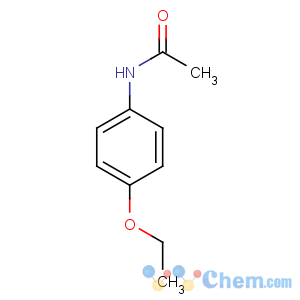Phenacetin Acetophenetidin Phenacetinum Phenacetin
-
- Product Name Phenacetin Acetophenetidin Phenacetinum Phenacetin
- CAS No.62-44-2
- Purity99%
- Min Quantity5000Kilograms
- Price1~10

 View Contact Detail
View Contact Detail
-
 Molecular Structure
Molecular Structure

- Phenacetin Acetophenetidin Phenacetinum Phenacetin
Detailed Description
Phenacetin Acetophenetidin Phenacetinum Phenacetin
CAS Number: 62-44-2
Formula: C10H13NO2
Molecular Weight: 179.24
Synonyms: Acetophenetidin; Acetophenetidine; Acetophenetin; Acetphenetidin; Fenidina; Fenina; Kalmin; NSC 7651; Pertonal; Phenacetin; Phenacetine; Phenazetin; Phenedina; Phenidin; Phenin; P-Ethoxyacetanilide;
EINECS: 200-533-0
Density: 1.099 g/cm3
Melting Point: 133-136 C(lit. )
Boiling Point: 355.1 C at 760 mmHg
Flash Point: 168.5 C
Solubility: 0.076 g/100 mL in water
Properties: white, scaly have flash or white crystalline powder, odorless, slightly bitter taste. This product is dissolved in ethanol or chloroform, slightly soluble in boiling water.
Packing: 25kg/drum
Uses: Antipyretic analgesics for the treatment of fever, headache, neuralgia.
Description :
Phenacetin is a pain-relieving and fever-reducing drug, widely used from its introduction in 1887 until banned in the US by the FDA in 1983. Its use has declined because of its adverse effects, which include increased risk of certain cancers and kidney damage. It is metabolized into paracetamol, which replaced it in some over-the-counter medications following the ban on phenacetin.
Phenacetin was introduced in 1887, and was used principally as an analgesic; it was one of the first synthetic fever reducers to go on the market. It is also known historically to be one of the first non-opioid analgesics without anti-inflammatory properties.
Applications :
Phenacetin was widely used until the third quarter of the twentieth century, often in the form of an "A.P.C." or aspirin-phenacetin-caffeine compound analgesic, as a remedy for fever and pain. An early formulation (1919) was Vincent's APC in Australia. However the U.S. Food and Drug Administration ordered the withdrawal of drugs containing phenacetin in November 1983, owing to its carcinogenic and kidney-damaging properties (Federal Register of October 5, 1983 (48 FR 45466)). It was also banned in India. As a result some branded, previously phenacetin-based preparations continued to be sold, but with the phenacetin replaced by safer alternatives. A popular brand of phenacetin was Roche's Saridon, which was reformulated in 1983 to contain propyphenazone, paracetamol and caffeine. Coricidin was also reformulated without phenacetin. Paracetamol is a metabolite of phenacetin with similar analgesic and antipyretic effects, but the new formulation has not been found to have phenacetin's carcinogenicity.
Phenacetin is now being used as a cutting agent to adulterate cocaine in the UK and Canada, owing to the similar physical features of the two drugs.
Due to low cost phenacetin is used for research into the physical and refractive properties of crystals. It is an ideal compound for this type of research